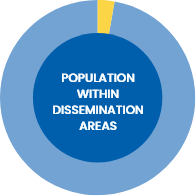
Environmental Justice
The Environmental Protection Agency (EPA) defines Environmental Justice (EJ) as the fair treatment and meaningful involvement of all people regardless of race, color, national origin, or income with respect to the development, implementation and enforcement of environmental laws, regulations and policies. At Waste Connections, our approach to community engagement and support is consistent with EJ and integral to our operating philosophy and environmental stewardship.
In addition to benefiting the health and well-being of the communities we are privileged to serve, our operations are frequently major employers in our communities, where many of our local leaders and frontline employees live and make local concerns a priority.
Facility siting and development are important EJ considerations. Our process requires regulatory reviews and includes opportunities for local input and consideration, which continue throughout the life of each site. Our vigorous internal processes ensure compliance with regulations and minimize community impacts.
Ej analysis of U.S.
operating sites
as of 2023


Ej analysis of canadian
operating sites
as of 2023


Our Board of Directors has oversight of our EJ efforts and receives periodic updates from our Executive Vice President — Engineering and Disposal and Vice President — Engineering and Sustainability, including discussion of EJ analysis, impacted areas and the steps we are taking to address local concerns.
We employ several methods to assess our company assets, enhancing our understanding of our impacts on local communities and identifying potential regulatory risks to ongoing operations. As part of our assessment completed in 2023, we utilized the EPA's EJScreen to evaluate the demographic attributes — including race and income — of our operating locations in the U.S. The tool calculates a demographic index to identify the most at-risk communities, overlaying our operating locations to indicate those sites with an elevated potential for impact on marginalized communities.
Our findings conclude that 33% of the population within the census tracts of our U.S. operating sites are minorities, below the EPA's estimated national average of 39%. Further, 86% of our U.S. operating sites fall below the 80th percentile of the EPA Demographic Index, which is the threshold for at-risk communities. For more information on our EJ efforts and impacts, please visit our complete Environmental Justice Report, found in the ESG hub of our website.
For our Canadian operations, we utilize Statistics Canada to identify locations near at-risk communities as defined by both income levels and Indigenous population. Our findings from 2023 conclude that across all of our Canadian operations, the median Indigenous population percentage is 3% within the dissemination areas where we operate, below the 5% population total for all Indigenous people in Canada. Further, only 34% of our Canadian operations are within Dissemination Areas that exceed the provincial average for Indigenous representation. Our findings also conclude that 2% of our operating locations in Canada are within dissemination areas that are considered low income or below half of the median after-tax income for all Canadians.




